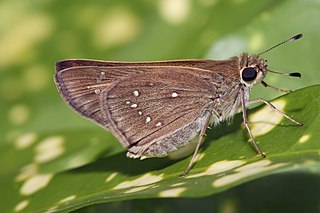
Skippers are a family of the Lepidoptera named the Hesperiidae. Being diurnal, they are generally called butterflies. They were previously placed in a separate superfamily, Hesperioidea; however, the most recent taxonomy places the family in the superfamily Papilionoidea, the butterflies. They are named for their quick, darting flight habits. Most have their antenna tips modified into narrow, hook-like projections. Moreover, skippers mostly have an absence of wing-coupling structure available in most moths. More than 3500 species of skippers are recognized, and they occur worldwide, but with the greatest diversity in the Neotropical regions of Central and South America.

Biological databases are libraries of biological sciences, collected from scientific experiments, published literature, high-throughput experiment technology, and computational analysis. They contain information from research areas including genomics, proteomics, metabolomics, microarray gene expression, and phylogenetics. Information contained in biological databases includes gene function, structure, localization, clinical effects of mutations as well as similarities of biological sequences and structures.

The eastern brown snake, often referred to as the common brown snake, is a species of highly venomous snake in the family Elapidae. The species is native to eastern and central Australia and southern New Guinea. It was first described by André Marie Constant Duméril, Gabriel Bibron, and Auguste Duméril in 1854. The adult eastern brown snake has a slender build and can grow to 2 m (7 ft) in length. The colour of its surface ranges from pale brown to black, while its underside is pale cream-yellow, often with orange or grey splotches. The eastern brown snake is found in most habitats except dense forests, often in farmland and on the outskirts of urban areas, as such places are populated by its main prey, the house mouse. The species is oviparous. The International Union for Conservation of Nature classifies the snake as a least-concern species, though its status in New Guinea is unclear.

Pseudonaja is a genus of highly venomous elapid snakes native to Australia. Species of this genus are known commonly as brown snakes and are considered to be some of the most dangerous snakes in the world; even young snakes are capable of delivering a fatal envenomation to a human.

Nepticulidae is a family of very small moths with a worldwide distribution. They are characterised by eyecaps over the eyes. These pigmy moths or midget moths, as they are commonly known, include the smallest of all living moths, with a wingspan that can be as little as 3 mm in the case of the European pigmy sorrel moth, but more usually 3.5–10 mm. The wings of adult moths are narrow and lanceolate, sometimes with metallic markings, and with the venation very simplified compared to most other moths.
The Catalogue of Life is an online database that provides an index of known species of animals, plants, fungi, and microorganisms. It was created in 2001 as a partnership between the global Species 2000 and the American Integrated Taxonomic Information System. The Catalogue interface is available in twelve languages and is used by research scientists, citizen scientists, educators, and policy makers. The Catalogue is also used by the Biodiversity Heritage Library, the Barcode of Life Data System, Encyclopedia of Life, and the Global Biodiversity Information Facility. The Catalogue currently compiles data from 168 peer-reviewed taxonomic databases that are maintained by specialist institutions around the world. As of June 2021, the Catalogue lists 1,997,284 of the world's 2.2m extant species known to taxonomists on the planet at present time.
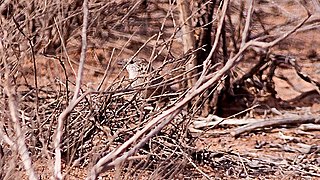
The thick-billed grasswren is a species of bird in the family Maluridae. It is endemic to Australia. Its natural habitat is Mediterranean-type shrubby vegetation.
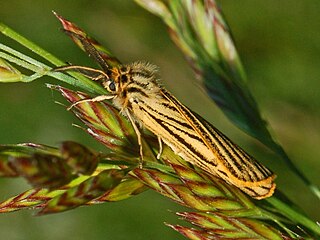
Spiris striata, the feathered footman, is a moth of the family Erebidae. The species was first described by Carl Linnaeus in his 1758 10th edition of Systema Naturae.
Metexilisia is a monotypic moth genus in the subfamily Arctiinae. Its single species, Metexilisia citrago, is found in Madagascar. Both the genus and species were first described by Hervé de Toulgoët in 1958.

Poppaea is a genus of moths of the family Noctuidae containing the sole species Poppaea sabina, known from East Africa.
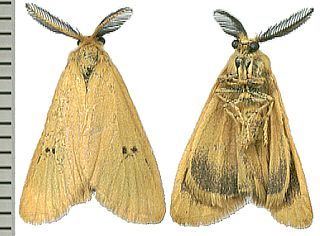
Bracharoa is a genus of moths in the subfamily Lymantriinae. The genus was erected by George Hampson in 1905.
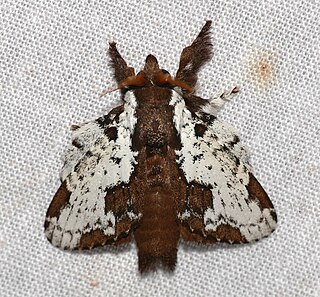
Euglyphis is a genus of moths in the family Lasiocampidae. The genus was erected by Jacob Hübner in 1820.
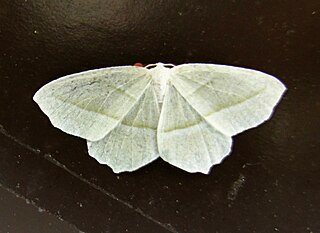
Campaea is a genus of moths in the family Geometridae first described by Jean-Baptiste Lamarck in 1816.

Syndromodes is a genus of moths in the family Geometridae.

The Erebinae are a subfamily of moths in the family Erebidae erected by William Elford Leach in 1815. Erebine moths are found on all continents except Antarctica, but reach their greatest diversity in the tropics. While the exact number of species belonging to the Erebinae is not known, the subfamily is estimated to include around 10,000 species. Some well-known Erebinae include underwing moths (Catocala) and witch moths (Thermesiini). Many of the species in the subfamily have medium to large wingspans, up to nearly 30 cm in the white witch moth, which has the widest wingspan of all Lepidoptera. Erebine caterpillars feed on a broad range of plants; many species feed on grasses and legumes, and a few are pests of castor bean, sugarcane, rice, as well as pistachios and blackberries.
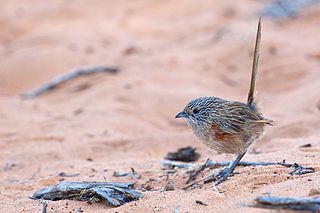
The western grasswren, also referred to as the thick-billed grasswren and, formerly, as the textile wren, is a species of bird in the family Maluridae. It is endemic to Australia. It was formerly lumped as the nominate subspecies of the thick-billed grasswren.
Ascaptesyle submarginata is a moth of the subfamily Arctiinae. It was described by William Schaus in 1905. It is found in Trinidad. No subspecies are listed in the Catalogue of Life.
Catephia dipterygia is a species of moth of the family Erebidae. It is found in Ghana.

Agathia hemithearia is a species of moth in the family Geometridae. It was first described by Achille Guenée in 1857. It is found in India, Sri Lanka, China (Hainan), Taiwan and Thailand.

Bambusa textilis, also known as slender bamboo, clumping bamboo and weaver's bamboo, is a species of bamboo in the Poaceae (grasses) family that is native to China. The subspecies var. gracilis is heavily cultivated in Australia.


















